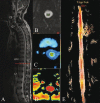Diffusion tensor imaging in spinal cord injury
- PMID: 22013299
- PMCID: PMC3190496
- DOI: 10.4103/0971-3026.85372
Diffusion tensor imaging in spinal cord injury
Abstract
Background and purpose: To assess the feasibility of spinal tractography in patients of spinal cord injury vs a control group and to compare fractional anisotropy (FA) values between the groups.
Materials and methods: Diffusion tensor imaging (DTI) was performed in the spinal cord of 29 patients (18 patients and 11 controls). DTI was done in the cervical region if the cord injury was at the dorsal or lumbar region and in the conus region if cord injury was in the cervical or dorsal region. FA was calculated for the patients and the controls and the values were compared.
Results: The mean FA value was 0.550±0.09 in the control group and 0.367±0.14 in the patients; this difference was statistically significant (P=0.001).
Conclusion: Spinal tractography is a feasible technique to assess the extent of spinal cord injury by FA, which is reduced in patients of spinal cord injury, suggesting possible Wallerian degeneration. In future, this technique may become a useful tool for assessing cord injury patients after stem cell therapy, with improvement in FA values indicating axonal regeneration.
Keywords: Fractional anisotropy; MRI; spinal cord injury; tensor imaging.
Conflict of interest statement
Figures

Similar articles
-
Efficacy of diffusion tensor anisotropy indices and tractography in assessing the extent of severity of spinal cord injury: an in vitro analytical study in calf spinal cords.Spine J. 2012 Dec;12(12):1147-53. doi: 10.1016/j.spinee.2012.10.032. Epub 2012 Dec 16. Spine J. 2012. PMID: 23245938
-
Diffusion tensor tractography of residual fibers in traumatic spinal cord injury: a pilot study.J Neuroradiol. 2013 Jul;40(3):181-6. doi: 10.1016/j.neurad.2012.08.008. Epub 2013 Feb 18. J Neuroradiol. 2013. PMID: 23428240
-
Diffusion tensor imaging and fiber tractography of patients with cervical spinal cord injury.J Neurotrauma. 2010 Nov;27(11):2033-40. doi: 10.1089/neu.2009.1265. J Neurotrauma. 2010. PMID: 20822462
-
The role of diffusion tensor imaging in the diagnosis, prognosis, and assessment of recovery and treatment of spinal cord injury: a systematic review.Neurosurg Focus. 2019 Mar 1;46(3):E7. doi: 10.3171/2019.1.FOCUS18591. Neurosurg Focus. 2019. PMID: 30835681
-
The role of diffusion tensor imaging and fractional anisotropy in the evaluation of patients with idiopathic normal pressure hydrocephalus: a literature review.Neurosurg Focus. 2016 Sep;41(3):E12. doi: 10.3171/2016.6.FOCUS16192. Neurosurg Focus. 2016. PMID: 27581308 Review.
Cited by
-
Feasibility of 3.0 T diffusion-weighted nuclear magnetic resonance imaging in the evaluation of functional recovery of rats with complete spinal cord injury.Neural Regen Res. 2015 Mar;10(3):412-8. doi: 10.4103/1673-5374.153689. Neural Regen Res. 2015. PMID: 25878589 Free PMC article.
-
Quantifying the impact of underlying measurement error on cervical spinal cord diffusion tensor imaging at 3T.J Magn Reson Imaging. 2016 Dec;44(6):1608-1618. doi: 10.1002/jmri.25308. Epub 2016 May 18. J Magn Reson Imaging. 2016. PMID: 27192379 Free PMC article.
-
Cervical Cord Neurodegeneration in Traumatic and Non-Traumatic Spinal Cord Injury.J Neurotrauma. 2020 Mar 15;37(6):860-867. doi: 10.1089/neu.2019.6694. Epub 2019 Nov 8. J Neurotrauma. 2020. PMID: 31544628 Free PMC article.
-
Spontaneous acute and chronic spinal cord injuries in paraplegic dogs: a comparative study of in vivo diffusion tensor imaging.Spinal Cord. 2017 Dec;55(12):1108-1116. doi: 10.1038/sc.2017.83. Epub 2017 Aug 1. Spinal Cord. 2017. PMID: 28762382
-
Does diffusion tensor data reflect pathological changes in the spinal cord with chronic injury.Neural Regen Res. 2013 Dec 25;8(36):3382-90. doi: 10.3969/j.issn.1673-5374.2013.36.003. Neural Regen Res. 2013. PMID: 25206660 Free PMC article.
References
-
- Lin VW, Cardenas DD, Cutter NC, Frost FS, Hammond MC. New York: Demos Medical Publishing; 2002. Spinal Cord Medicine: Principles and Practice.
-
- Inglese M, Makani S, Johnson G, Cohen BA, Silver JA, Gonen O, et al. Diffuse axonal injury in mild traumatic brain injury: A diffusion tensor imaging study. J Neurosurg. 2005;103:298–303. - PubMed
LinkOut - more resources
Full Text Sources
Medical

